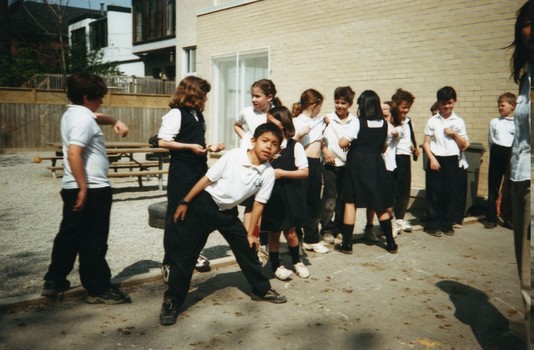Children who take short walks during sedentary periods can lower their blood sugar and fats, and insulin, says a study by the National Institute of Health. The study findings show that brief times of exercise during inactive periods such as sitting in a classroom could protect children against diabetes, cancer, and cardiovascular disease. The findings were published in the Journal of Clinical Endocrinology and Metabolism.
“Our study indicates that even small activity breaks could have a substantial impact on children’s long-term health,” said Jack A. Yanovski, M.D. Dr. Yanovski is the Chief of the Eunice Kennedy Shriver National Institute of Child Health and Human Development’s (NICHD) Section on Growth and Obesity.
The children who participated in the research were seated for three hours. The researchers measured their blood glucose and insulin levels while they were sedentary and a day later while the participants walked at a moderate intensity level for three minutes every half hour during a three hour period. On the day the children walked, they had lower levels of blood glucose and insulin. They ate the same amount of lunch on the day they were sedentary as they did on the day they walked. The activity did not seem to increase their appetite.
“We know that 30 minutes or more of moderate physical activity benefits children’s health,” said the study’s senior author, Jack A. Yanovski, M.D., chief of NICHD’s Section on Growth and Obesity. “It can be difficult to fit longer stretches of physical activity into the day. Our study indicates that even small activity breaks could have a substantial impact on children’s long-term health.” Currently, children in the U.S. spend approximately six hours a day in a sedentary position such as reclining or sitting.
“Sustained sedentary behavior after a meal diminishes the muscles’ ability to help clear sugar from the bloodstream,” said first author, Britni Belcher, PhD, a Cancer Prevention Fellow in NCI’s Health Behavior Research Branch and currently an assistant professor at the University of Southern California. “That forces the body to produce more insulin, which may increase the risk for beta cell dysfunction that can lead to the onset of type 2 diabetes. Our findings suggest even short activity breaks can help overcome these negative effects, at least in the short term.”
The researchers studied 28 healthy, normal-weight children in the Bethesda, Maryland area. The children were divided in two groups. In the first group, children remained seated for three hours while reading, watching TV, or other sedentary activities. The children in the second group were both sitting and walking on a treadmill at a moderate-intensity level for three minutes every half hour during the three hour period. The groups were then switched so that the sedentary group was active and the active group was sedentary.
The children drank a soda-like drink called glucola and then took an oral glucose tolerance test. Researchers then tested them to determine how quickly their bodies absorbed glucose and to measure the amount of insulin they produce. Glucose levels were, on average, seven percent lower than on the days the participants were sedentary, and insulin levels were 32 percent lower. Blood levels of free fatty acids and C-peptides were also lower, demonstrating how hard the pancreas was working to control blood sugar levels. High levels of fatty acids have been linked to type 2 diabetes.
Dr. Yanovski said that more research studies were needed to determine whether exercise breaks in the classroom can become a strategy to prevent obesity-related illness in school-age children. Previous research studies have linked being sedentary to insulin resistance, a risk factor for type 2 diabetes, and obesity.








